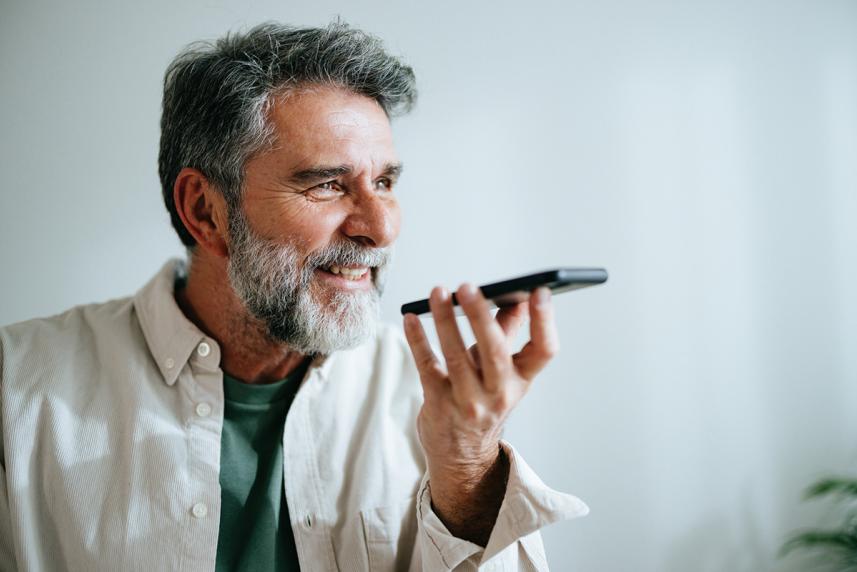
Changes in hearing can be subtle at first. Find out if hearing loss may be interfering with your life.
Get the inside scoop from hearing expert Monica Murray, Au.D., of UnitedHealthcare Hearing.

Many people start to notice hearing problems as they get older. And wearing hearing aids could make a big difference. Whether you’re new to the world of hearing aids or you’ve been wearing these devices for a while now, it’s normal to have some questions. In this new series, an expert audiologist at UnitedHealthcare Hearing gives helpful advice about common concerns.
How can I hear better on my smartphone when I'm wearing my hearing aids? I love chatting with family and friends, but it can be frustrating.
This is a common issue for people who wear [hearing aids]. [LINK TO: “What every adult needs to know about hearing aids”] But there are some simple strategies that can make the conversation sound clearer and help you get back to enjoying your calls with loved ones instead of feeling stressed.
Put the phone on speaker. This is my number one recommendation. When you use the speaker setting on your phone, you’re able to hear the person on the other end of the call with both ears. That’s a huge benefit. We all hear better with two ears — and when you hold the phone to your ear, you only hear with one ear.
This is the best option for when you’re at home or in another private space where you can use the speaker without bothering anyone nearby.

Changes in hearing can be subtle at first. Find out if hearing loss may be interfering with your life.
Have a video call. Whether you’re an iPhone or Android user, you can make a phone call with video too.
This is also a great option. You’re looking at the person and hearing their voice through the speaker at the same time, which means you can see their mouth, facial expressions and even hand gestures. Part of [understanding what someone is saying] is seeing them. [LINK TO: “How to help your loved one hear you better”] You miss out on those visual clues when you’re on a traditional phone call.
Position the phone properly if you hold it up to your ear. Sometimes it’s not possible to chat using the speaker or a video call. Maybe you’re in a public place like a store, the gym or a doctor’s office, for example. So you’ll need to hold the phone to your ear to have your conversation.
This can get a bit tricky when you wear hearing aids. You don’t want to place the phone receiver against your ear canal, the way people normally do. That's not going to amplify anything. And it actually could even block the sound because you already have something else in your ear.
Instead, position the phone receiver against the microphone on your hearing aid. If you’re wearing behind-the-ear hearing aids, that will be up behind your ear. This can help your caller’s voice come through clearly in your hearing aid.
Use Bluetooth. Do you have Bluetooth capability in your hearing aids? You can usually stream the call from your phone directly into your hearing aids. This is really helpful because you can hear the conversation in both ears. Just ensure your hearing aids are [paired (connected) properly to Bluetooth] on your phone. If you’re having trouble pairing them, try calling the hearing aid manufacturer’s tech support team.
With all these options, you should be able to hear your phone conversations more easily, no matter where you are. Still having issues? Your [hearing care professional] may be able to help you troubleshoot. [LINK TO: “How to find a hearing care professional you trust”]
Did you know that you may be able to request a no-cost hearing exam and consultation through AARP® Hearing Solutions™ for UnitedHealthcare Hearing? Request an appointment.
Meet the expert
Monica Murray, Au.D., is senior director of program development at UnitedHealthcare Hearing and a nationally recognized hearing health expert.
Information is for educational purposes only and is not a substitute for the advice of a licensed medical provider. Consult your provider prior to making changes to your lifestyle or health care routine.
AARP Hearing Solutions is available to all AARP members and does not require a health insurance plan from UnitedHealthcare. The AARP hearing program discount cannot be combined with any other discounts, promotions, coupons or hearing aid benefit plans unless noted herein. Products or services that are reimbursable by federal programs including Medicare and Medicaid are not available on a discounted or complimentary basis. AARP commercial member benefits are provided by third parties, not by AARP or its affiliates. Providers pay a royalty fee to AARP for the use of its intellectual property. These fees are used for the general purposes of AARP. Some provider offers are subject to change and may have restrictions. Please contact the provider directly for details. UnitedHealthcare Hearing is provided through UnitedHealthcare, offered to existing members of certain products underwritten or provided by UnitedHealthcare Insurance Company or its affiliates to provide specific hearing aid discounts. This is not an insurance nor managed care product, and fees or charges for services in excess of those defined in program materials are the member's responsibility. UnitedHealthcare does not endorse nor guarantee hearing aid products/services available through the hearing program. This program may not be available in all states or for all group sizes. Components subject to change.